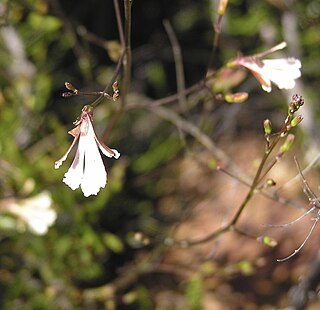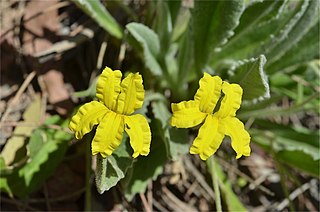
Scaevola hookeri, commonly known as the creeping fan-flower or alpine fan-flower, is a species of flowering plant in the family Goodeniaceae. It has white or blue flowers with a yellow throat and grows in eastern Australia.

Goodenia lanata, commonly known as trailing goodenia in Victoria and native primrose in Tasmania is a species of flowering plant in the family Goodeniaceae and is endemic to south-eastern Australia. It is a prostrate or low-lying perennial herb with hairy, egg-shaped leaves and racemes of yellow flowers.
Scaevola macrophylla, commonly known as large-flowered scaevola, is an erect herb growing to 0.4 m high, with blue flowers, in the family Goodeniaceae, native to Western Australia.

Scaevola humifusa is a prostrate shrub in the family Goodeniaceae, native to Western Australia. It grows to a height of 0.01 to 0.5 m, and its white-cream/white-blue flowers may be seen from August to November or January.

Scaevola repens is a shrub in the family Goodeniaceae, endemic to the south west of Western Australia.

Goodenia amplexans, commonly known as clasping goodenia, is a species of flowering plant in the family Goodeniaceae and endemic to South Australia. It is a small shrub with sticky foliage, egg-shaped to oblong or elliptic, stem-clasping leaves with small teeth on the edges, racemes of yellow flowers with leaf-like bracteoles at the base, and elliptic fruit.

Goodenia armstrongiana is a species of flowering plant in the family Goodeniaceae and is native to northern Australia and New Guinea. It is an erect to low-lying herb with egg-shaped to narrow elliptic leaves, sometimes with small teeth on the edges, racemes of white or yellow flowers with leaf-like bracts at the base, and oval fruit.

Goodenia azurea, commonly known as blue goodenia, is a species of flowering plant in the family Goodeniaceae and is endemic to northern Australia. It is an erect, dense, spreading or sprawling, glaucous, perennial herb with egg-shaped leaves with the narrower end towards the base, racemes or thyrses of bluish-purple flowers with leaf-like bracts, and oval to cylindrical fruit.

Goodenia blackiana, commonly known as Black's goodenia, is a species of flowering plant in the family Goodeniaceae and is endemic to southern Australia. It is a herb with egg-shaped to lance-shaped leaves with the narrower end towards the base, and racemes of yellow flowers.

Goodenia glabra, commonly known as shiny pansy or smooth goodenia, is a species of flowering plant in the family Goodeniaceae and is endemic to drier inland areas of Australia. It is a prostrate to low-lying herb with lobed, oblong to egg-shaped leaves, and racemes of yellow flowers with purplish markings.
Goodenia laevis, commonly known as smooth goodenia, is a species of flowering plant in the family Goodeniaceae and is endemic to south-western Western Australia. It is a prostrate or ascending sub-shrub with oblong to lance-shaped leaves with the narrower end towards the base and racemes or thyrses of yellow flowers with purplish markings.
Goodenia mimuloides is a species of flowering plant in the family Goodeniaceae and is endemic to inland areas of Western Australia. It is a low-lying to ascending, densely hairy herb, with narrow egg-shaped, toothed or lobed leaves, and racemes of yellow flowers.

Goodenia pinifolia, commonly known as pine-leaved goodenia, is a species of flowering plant in the family Goodeniaceae and is endemic to the southwest of Western Australia. It is an erect or spreading shrub with linear or tapering leaves on the stems, loose racemes of white or pale blue flowers, and more or less spherical fruit.

Goodenia pusilla is a species of flowering plant in the family Goodeniaceae and is endemic to the southwest of Western Australia. It is an ascending herb with lance-shaped to egg-shaped leaves at the base of the plant and single yellow flowers with brownish markings.

Goodenia robusta, commonly known as woolly goodenia, is a species of flowering plant in the family Goodeniaceae and is endemic to southern Australia. It is an erect or ascending perennial herb with crowded, hairy, elliptic to narrow oblong leaves at the base of the plant, and racemes of yellow flowers.
Goodenia trichophylla is a species of flowering plant in the family Goodeniaceae and is endemic to the southwest of Western Australia. It is an erect to ascending herb with sticky or shiny, linear leaves at the base of the plant and racemes of blue flowers.

Goodenia viscida, commonly referred to as viscid goodenia, is a species of flowering plant in the family Goodeniaceae and is endemic to the south-west of Western Australia. It is an erect perennial herb or shrub with narrow oblong to egg-shaped leaves with toothed edges, and spikes of yellow flowers.

Goodenia xanthotricha, commonly known as yellow-haired goodenia, is a species of flowering plant in the family Goodeniaceae and is endemic to a restricted area in the southwest of Western Australia. It is a herb-like shrub with sticky foliage, linear to lance-shaped leaves with the narrower end towards the base, racemes of blue flowers, and cylindrical to oval fruit.

Conostephium preissii is a species of flowering plant in the family Ericaceae and is endemic to the southwest of Western Australia. It is an erect shrub with many stems, egg-shaped to oblong leaves and white and purplish to reddish-pink flowers.
Thomasia rulingioides is a species of flowering plant in the family Malvaceae and is endemic to the south-west of Western Australia. It is an erect, open shrub with densely hairy new growth, narrowly oblong to narrowly egg-shaped leaves with wavy edges, and pink to purple flowers.















